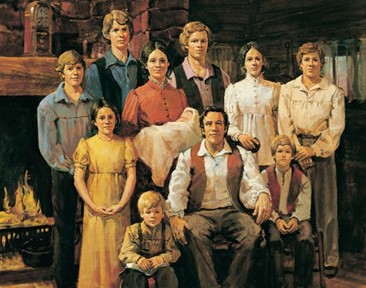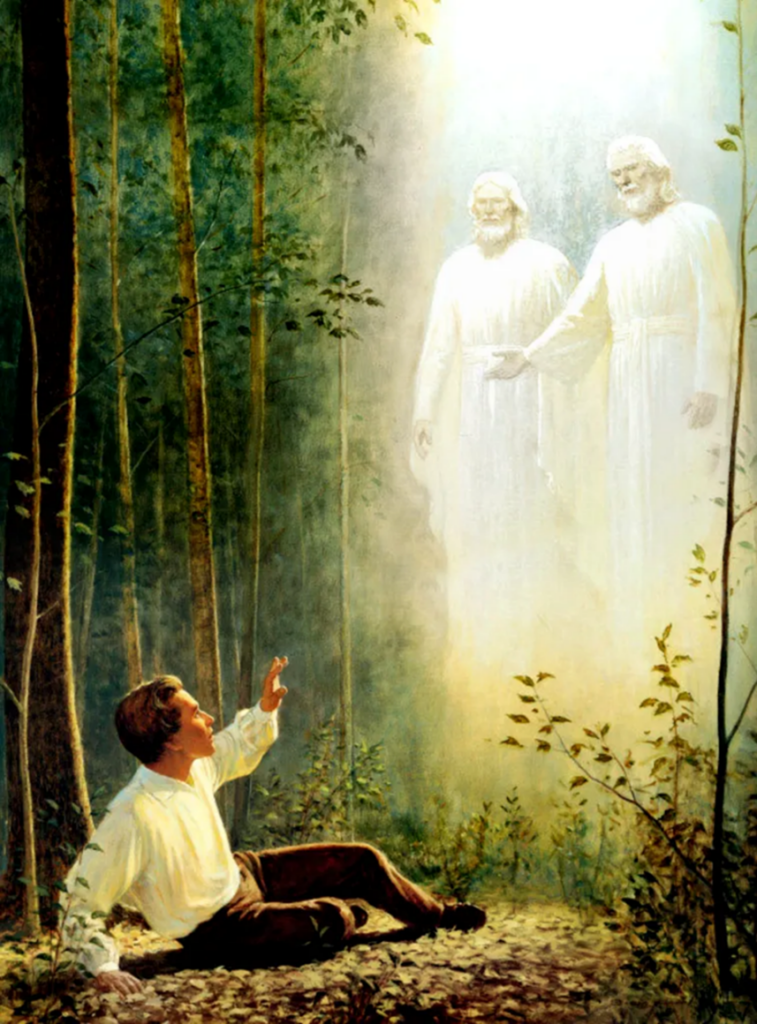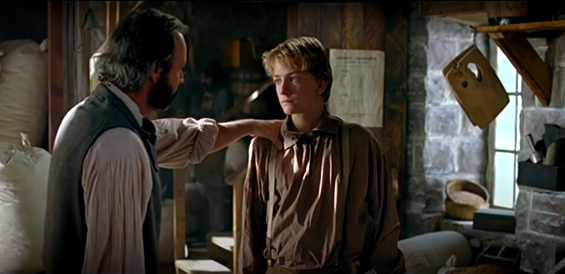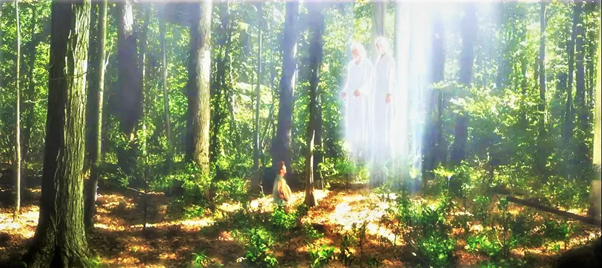Points to Ponder in Joseph Smith—History 1:1-26 and in Voices of the Restoration: Joseph Smith’s Family in this week’s Come Follow Me Material
To accompany your Come Follow Me study for January 13-19
In addition to reading JS-H 1:1-26 and the Voices of the Restoration material this week, you will enjoy watching the following videos:
If you would like to have a Kahoot game related to this material that you can use with your family or with a class, click here: https://create.kahoot.it/share/joseph-smith-history-1-1-26-first-vision/5b026e98-0e80-4fc3-b4a0-865cebc14913. To use it with a group, after clicking on this link, you will need to log into Kahoot, creating a free account if you have not done so previously, then click on the blue “Host Live” button or the gray “Assign” button, depending on how you wish to use the Kahoot. Some of the Kahoot questions may presuppose that the player has read through the suggested answers to the following Points to Ponder and at least has browsed the Institute student manual as well.
Points to Ponder in “Voices of the Restoration: Joseph Smith’s Family”
- What did you consider the three most impressive points made in this section about Joseph Smith’s parents?

Points to Ponder in Joseph Smith—History 1:1-26
1. How many errors, stated or implied, can you find in the following simplified but intentionally garbled version of Joseph Smith’s First Vision? I think there are seven, though it may not be easy to find the seventh unless you read the fifth in the series of Lectures on Faith that Joseph Smith and his associates prepared for presentation to the School of the Prophets in Kirtland, Ohio. If you want to go the extra mile, you can read that lecture at http://www.lecturesonfaith.com/5/.
As a young man of fourteen, Joseph Smith was confused by local revivals where ministers taught so many contradictory things. He wanted to know what Church was true. One day he happened to read James 1:5, which suggested he pray about it. Accordingly, he went out into the woods near his home and for the first time in his life vocally called upon God. In response to his prayer, God the Father, together with His Son, Jesus Christ, promptly appeared to Joseph. In response to the burning question in Joseph’s heart, they told him no Church on earth was true but that through Joseph the gospel would eventually be restored. Additionally, Joseph Smith learned that contrary to what the ministers of his day were teaching, the Father and the Son are two separate beings and that both have a body of flesh and bones, as tangible as man’s.
In preparing your answer to this question, you’ll want to take a look at the composite version of the First Vision I have posted at https://latterdaysaintandhappy.com/o-how-lovely-was-the-morning/. Joseph Smith told the story of his First Vision on several recorded occasions, and the composite account draws the most essential information from each.

2. How would you respond to the argument that the existence of several different versions of the First Vision, each giving different details, should cause us to question serious whether or not the event even happened?
3. List five separate tactics tried by Satan in the Sacred Grove in an effort to keep the First Vision from happening. What do you feel are the most important lessons we can learn from this?
4. In addition to learning that his sins were forgiven, that the true church was not on the earth, that the Father and the Son are separate beings, and that the fulness of the gospel would be eventually made known to him, what important things did Joseph Smith learn in his First Vision?
5. Who else can you think of in the scriptures who was left spiritually exhausted by a great spiritual experience?

6. Some have pointed out that the story of the First Vision was not told often by Joseph Smith and was almost unknown among early Latter-day Saints compared to the story of the visit of Moroni and the discovery of the plates. List two reasons why this may have been true.
Possible answers to Points to Ponder in “Voices of the Restoration: Joseph Smith’s Family”
1. What did you consider the three most impressive points made in this section about Joseph Smith’s parents?
Your choice. Mine would probably be:
- Lucy’s hearing a voice from the Savior.
- Lucy’s energetically trying to get her children to seek after religion, but always with love
- Joseph’s father’s never doing a mean act in his life, so far as young Joseph could remember.
Possible Answers to Points to Ponder in JS—History 1:1-26
1. How many errors, stated or implied, can you find in the following simplified but intentionally garbled version of Joseph Smith’s First Vision? Joseph Smith told the story of his First Vision on several recorded occasions. In preparing your answer to this question, you’ll want to take a look at the composite version of the First Vision I have posted at https://latterdaysaintandhappy.com/o-how-lovely-was-the-morning/.
As a young man of fourteen, Joseph Smith was confused by local revivals where ministers taught so many contradictory things. He wanted to know what Church was true. One day he happened to read James 1:5, which suggested he pray about it. Accordingly, he went out into the woods near his home and for the first time in his life vocally called upon God. In response to his prayer, God the Father, together with His Son, Jesus Christ, promptly appeared to Joseph. In response to the burning question in Joseph’s heart, they told him no Church on earth was true but that through Joseph the gospel would eventually be restored. Additionally, Joseph Smith learned that contrary to what the ministers of his day were teaching, the Father and the Son are two separate beings and that both have a body of flesh and bones, as tangible as man’s.
a. This was not just a quick reaction to recent revivals. Young Joseph had been pondering deeply for at least a couple of years.
b. Joseph didn’t just happen upon James 1:5, but it was the text of a sermon given by one of the local ministers. Not only that passage but also Matthew 7:7 (“Ask, and it shall be given you; seek and ye shall find”) was instrumental in persuading Joseph to give prayer a try,
c. Rather than “promptly appear,” God allowed Satan to test Joseph severely first. We don’t know how long that demonic opposition lasted, but I suspect it seemed more than just a couple of minutes to the young prophet.
d. Evidently, the Father appeared alone to Joseph first, followed shortly thereafter by the Son.
e. The most “burning” question on Joseph’s mind had to do with his standing before God. Accordingly, the first message to Joseph seems to have been that his sins were forgiven. Thereafter, in response to Joseph’s question, the Savior told him that the true Church was not then on the earth and that he should join none of those with which he was acquainted.
f. Joseph was evidently not told at this time that he was to be the means by which the true church would be restored—only that in due time the fulness of the gospel would be made known to him. It appears to have been Moroni, in 1823, who first told Joseph that “God had a work” for him to do.
g. Though it must have been obvious to Joseph that the Father and the Son were two separate beings, there is no record of their having touched him. It appears he may have believed as late as when the Lectures on Faith were prepared for delivery to the School of the Prophets that while the Son had a body of flesh and bones, the Father was only a personage of Spirit. Even prophets learn “line upon line.”
2. How would you respond to the argument that the existence of several different versions of the First Vision, each giving different details, should cause us to question serious whether or not the event even happened?
This is exactly what we would expect from one who was telling the truth. Joseph Smith chose to emphasize certain details on one occasion and other details on another, depending on his audience. The different accounts are complementary, not contradictory. If he always told the same story exactly the same way, as a memorized monologue, we’d have much more reason to question his veracity. It’s worth noting that the New Testament gives differing accounts of some of Jesus’ sermons and miracles and gives two different accounts of Saul’s conversion, but no one views that as a reason to question their historicity.
3. List five separate tactics tried by Satan in the Sacred Grove in an effort to keep the First Vision from happening. What do you feel are the most important lessons we can learn from this?
- Caused thick darkness to appear
- Caused a swelling in Joseph’s tongue, so he could not speak
- Caused distracting noise, as though someone was walking
- Presented all kinds of inappropriate images before Joseph
- Caused feelings of doubt and despair
From this we can learn that the divine voice is most easily heard and felt in an atmosphere of peace, without worldly distractions, and that “inappropriate images” are absolutely incompatible with the Spirit of the Lord. We learn that darkness is a symbol of Satan and his power, just as the Lord is symbolized by light. Perhaps this is one reason bars and other inappropriate places generally have the lights turned down low. We learn that we can pray in our hearts even when prevented from doing so vocally. And we learn that we don’t need to give in to feelings of doubt and despair but that if we persist, the answers and blessings we are seeking will come. But often they will not come until “after the trial” of our faith.

4. In addition to learning that his sins were forgiven, that the true church was not on the earth, that the Father and the Son are separate beings, and that the fulness of the gospel would be eventually made known to him, what important things did Joseph Smith learn in his First Vision?
- That God knew him individually. He called him by name.
- That revelation is real and ongoing.
- That God listens even to a confused teenager.
- That the power of Satan is real and strong, but that God’s power is greater.
- That God has a human form
- That God is a being of great brightness and glory
- That the Father and the Son exactly resemble each other
- That great spiritual experiences can be accompanied by physical exhaustion
- Spiritual experiences are accompanied by peace, calm, love, and joy.
5. Who else can you think of in the scriptures who was left spiritually exhausted by a great spiritual experience?
- Moses (Moses 1:9-10)
- Daniel (Daniel 10:15-17)
- Saul (Acts 9:4)
- Lehi (1 Nephi 1:7)
- Alma (Mosiah 27:19)
- Lamoni (Alma 18:42, 19:6)
- Ammon, Lamoni’s wife and servants (Alma 19:13-16)
- Lamoni’s father (Alma 22:18)
- Ammon again (Alma 27:17)
6. Some have pointed out that the story of the First Vision was not told often by Joseph Smith and was almost unknown among early Latter-day Saints compared to the story of the visit of Moroni and the discovery of the plates. List two reasons why this may have been true.
- In the first place, this was a sacred, personal experience. We are counseled not normally to share such with others. As has been noted, Joseph’s call to take the lead in the restoration came when Moroni visited him three and a half years later.
- When Joseph did share his experience with some, they treated his story with contempt and began to persecute him.

